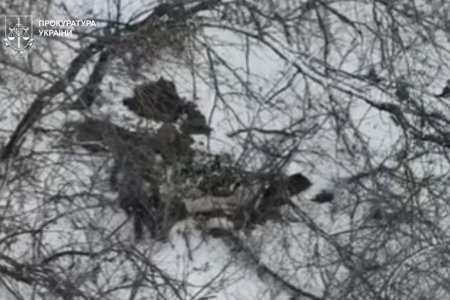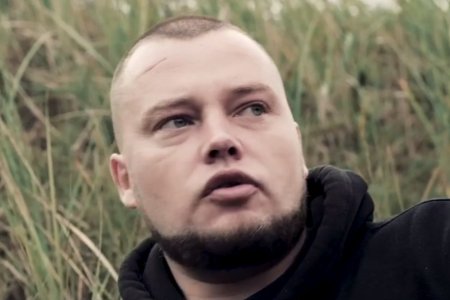
The trip to write this material fell on May 9, during another so-called “truce” announced by the Russian side. Volunteer Yevhen Tkachov reacts with a smile to the very word “truce”, saying this is his usual reaction now. During the previous “ceasefire”, which was initiated and declared by the Russian dictator Putin, volunteer Tkachov, along with civilians from the Donetsk region, came under a deadly drone attack.
Yevhen assists and rescues people from the frontline zone as part of the humanitarian organization “Proliska”, which has existed since 2014 and now works under the patronage of one of the UN structures. During his volunteer activities, Yevhen Tkachov was captured, received a death sentence, was released from the basements of LPR militants, and has come under targeted strikes by Russian weapons several times.
“Protestant — means American agent”
Yevhen Tkachov’s volunteer path began almost from the first days of the confrontation in Donbas. Back in April 2014, after Russian special forces and their supporters seized the administrative institutions of Sloviansk and attempted to cut off the city from communications with Ukraine, Yevhen and his comrades began humanitarian trips to the city captured by the militants. The volunteer recalls that in the first weeks, the militants, who surrounded the city with checkpoints, treated such trips neutrally. The volunteer-delivered medicine and food to Sloviansk, Debaltseve, and Horlivka and evacuated civilians from dangerous areas. However, the militants halted these humanitarian missions quite quickly.
“It was almost the end of the occupation of Sloviansk. That day, I was planning to evacuate a family with three or four children. They stopped me at the checkpoint and said my car was being wanted. I said: ‘I drive through your checkpoints every day!’” — recalls volunteer Yevhen.
The man suggests that the militants were probably more interested in the car, a Fiat Doblo, at first. Reports by many human rights organizations, as well as in criminal proceedings, constantly mentioned the “confiscation” of transport by the militants — “for the needs of the militia”. However, the DPR not only took the car but also arrested Yevhen.
![© Сергій Окунєв [Євген Ткачов, Проліска] © Serhii Okuniev](https://khpg.org/files/img/1608823571.jpg)
The man was sent “to the basement” to an illegal place of detention. Yevhen himself says that at first, he was treated neutrally and accused of “removing the cover”, that is, evacuating the civilian population, which the militants considered to be a cover. But later, the charges were reclassified.
“They found a Bible in my car and found out that I was a Protestant. And this is already ideological sabotage, which means that I am an American spy. We were tried by a peculiar group, like in Stalin’s times, by a trio: a worker at the Zaporizhzhia Metallurgical Plant, a retired colonel of the Soviet Army, and supposedly a lawyer from Donetsk,” — the man recalls. Yevhen was not the only detained believer. He does not know the exact number of those arrested for such “ideological sabotage.” Likely, the official investigation has not even established this. We know about at least four Pentecostals who were sentenced to death by the so-called “court” and shot.
“They were taken out in handcuffs and forced into the car under a gunpoint. Two deacons, the pastor’s son and nephew, were killed. They definitely didn’t help the military as they are pacifists, and it contradicts their faith,” says Yevhen.
The man managed to avoid such a destiny due to the rapid advance of Ukrainian troops. The militants and Russian special forces quickly left Sloviansk on July 5, 2014. The retreat was poorly organized, so they forgot about the captured volunteers and believers. This is how Yevhen Tkachov explains his release.
“There weren’t so many drones here before the armistice!”
With the beginning of the full-scale invasion, Yevhen, who already had volunteer experience and a vast network of connections and acquaintances in the Donetsk region, continued and intensified his activities. First, he took the elderly from a hospice previously founded in Chasiv Yar to the Rivne region. He then continued the work he was already familiar with: humanitarian aid and evacuation of civilians. Only the scale of the activity became much larger, and the danger even more acute.
![© Сергій Окунєв [Євген Ткачов, Проліска] © Serhii Okuniev](https://khpg.org/files/img/1608823572.jpg)
“Over the years, all sorts of things have happened. Both Bakhmut and Chasiv Yar were under constant shelling. And artillery was fired on the roads when we tried to take people out. And drones attacked. There was everything you could imagine!”
Yevhen Tkachov says that he knows of six cases of drone attacks on his car, but the occupiers themselves stopped two. These were cases when the volunteer saw an enemy drone, got out of the vehicle, and visually showed that he was not a military man. It worked twice.
“Was it humanism, or did they just decide not to spend expensive drones,” — I don’t know. There was a case when I saw a drone that was definitely moving towards us. I got out of the car and started showing my uniform, patches, and stickers. The drone turned around and started moving away. I thought the person, the operator, had a conscience and decided not to attack us. But it turned out that the drone moved away to gain momentum. And a few seconds later, he fell next to the car,” — the volunteer recalls.
But the most egregious incident occurred during the so-called “truce” on Easter, April 20, 2025. Then Yevhen tried to take advantage of a possible “silence” regime and tried to evacuate people near the city of Kostyantynivka.
“Previously, those families did not want to evacuate, but, apparently, they believed in the truce and decided to take advantage of the opportunity,” — Tkachov clarifies.
An enemy drone spotted the volunteer’s car. The man began to film what was happening on his smartphone. Thus, unique footage of a UAV attack on a vehicle with civilians was created. In the video, you can see that the drones circle the incident scene before a direct hit and only then fall near the car.
“Am I sure that the operator saw who we were? Well, about three or four thousand percent. If, in the case of the first drone, one doubts whether the operator saw or understood... But then there were several more strikes, and the drone flew a few meters from me, right next to the car.”
During the attack, Yevhen ordered the civilians who were in the transport to get out and hide under the branches. The volunteer says at least one drone could have aimed specifically at people while the others attacked the car. The car had identification marks in the form of inscriptions, white ribbons, and emblems of the volunteer organization. The people lying in the bushes nearby were older women. As a result of the attack, Yevhen himself and one of the women received minor shrapnel wounds, and the older man who had heart problems suffered an acute stress reaction.
![Люди ховалися від дронів під кущами [Євген Ткачов, Проліска, евакуація цивільних] People hid from the drones under the bushes](https://khpg.org/files/img/1608823574.jpg)
“After several explosions, the last drone was just circling above us. I think it was waiting for someone to come to our aid to save us. And then it would have attacked the other car as well. We had to escape using complicated routes.”
In the footage the volunteer filmed, his Fiat Doblo still did not have significant damage. However, he had to abandon it to save people. Later, the volunteer learned that the car was destroyed. Oleksandr Reshetnyk, a chaplain with whom Tkachov was held captive in Sloviansk in 2014, came to the aid of Yevhen and evacuated civilians.
![© Сергій Окунєв [Євген Ткачов, Проліска] © Serhii Okuniev](https://khpg.org/files/img/1608823573.jpg)
Civilian evacuation vehicles have an inviolable status, even in a combat zone. An attack on them is a direct violation of international humanitarian law and a war crime.
The Rome Statute of the International Criminal Court stipulates that:
“A deliberate attack against the civilian population as such or against individual civilians not taking a direct part in the hostilities is a war crime.” (Article 8(2)(b)(i))
“A deliberate attack on medical or humanitarian transport, if they are entitled to protection under the Geneva Conventions, is also a war crime.” (Article 8(2)(b)(xxiv)).
At the same time, throughout the full-scale invasion, Russian forces have regularly attacked and continue to attack volunteers, civilian medics, and civilian evacuation teams. Read about one such case in the article on the last days of unoccupied Kurakhove.
![© Сергій Окунєв [Євген Ткачов, Проліска] © Serhii Okuniev](https://khpg.org/files/img/1608823570.jpg)



